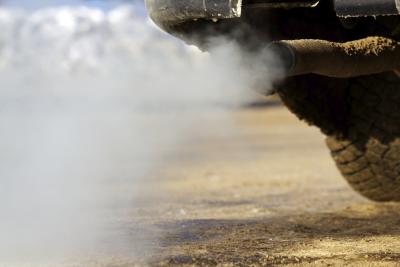Diesel truck engines come in domestic and commercial grades, and they run on a thick, oily fuel that has an ignition temperature of about 540 degrees Fahrenheit. Analyzing the color and smell of diesel exhaust emissions can tell you the performance and component conditions of the engine. Diesel engines can emit blue, black or white smoke from their exhaust while running, and each color can indicate a fault with a part or system. White smoke points to some very specific conditions which can indicate a number of component or system failures. A process of elimination is required to find out the source and severity of white smoke emissions.

Condensation that accumulates inside the exhaust pipes, converter and mufflers can produce a puff of white smoke upon diesel engine start-up. In very cold temperatures, the heated exhaust can freeze into minute fuel droplets when exiting the exhaust and produce a more prolonged emission of white smoke for a very short period of driving time. However, the white smoke will disappear once the engine has reached normal operating temperature.

A steady stream of white smoke during normal driving conditions points to fuel vapors, or in some cases, raw fuel exiting the exhaust. Worn or defective glow plugs, improper engine timing and defective fuel pump pressure will allow excess fuel to exit the exhaust in the form of white smoke. Low cylinder compression ie., burnt valves and worn rings will allow the passage of unburned fuel due to incomplete engine combustion. Diesel injectors that do not have a maximum spray pattern (dirty nozzles) can allow raw fuel passage through the exhaust, as well as a faulty waste gate. Such unburned fuel will have a strong petrol odor and will sting the eyes.

Water contaminated fuel that is pumped through the fuel delivery system will burn with a steam effect in the cylinder, exiting the exhaust in the form of white smoke. Condensation can accumulate inside a vehicle fuel tank that is less than full, especially if it has sat for weeks or months. Water can be picked up from the bottom of fuel storage tanks, such as those found in gas stations. This happens when underground water seepage has contaminated the fuel in the storage tanks, and the level is very low.

A worn or blown head gasket, particularly near the exhaust port side, will cause liquid coolant to enter the cylinders and pass through the exhaust in the form of vaporous steam. A cracked engine block or cylinder head will produce the same effect. The coolant passage through the hot exhaust will emit a sweet smell, rather than an odor of unburned fuel. A continuous loss of radiator or reservoir coolant indicates the first signs of a blown head gasket, cracked head or block.

Vehicles equipped with vacuum modulators, a component located on the side of the transmission case, can have a faulty diaphragm valve that allows transmission fluid to enter the intake system through the vacuum hose-line. The first indication will be a noticeable shifting problem with the automatic transmission, followed by excessive transmission fluid consumption. Burning transmission fluid will appear white, just like unburned fuel, but will give off an acrid smell. Diagnoses is accomplished by pulling the vacuum line from the modulator and noticing transmission fluid leakage inside the line and out of the modulator nipple connection.
